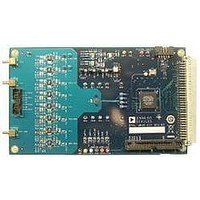EVAL-AD7689EDZ Analog Devices Inc, EVAL-AD7689EDZ Datasheet - Page 21

EVAL-AD7689EDZ
Manufacturer Part Number
EVAL-AD7689EDZ
Description
BOARD EVAL AD7689
Manufacturer
Analog Devices Inc
Series
PulSAR®r
Specifications of EVAL-AD7689EDZ
Number Of Adc's
1
Number Of Bits
16
Sampling Rate (per Second)
250k
Data Interface
Serial
Inputs Per Adc
8 Single Ended
Input Range
±VREF
Power (typ) @ Conditions
12.5mW @ 250kSPS, 5 V
Voltage Supply Source
Single Supply
Operating Temperature
-40°C ~ 85°C
Utilized Ic / Part
AD7689
Silicon Manufacturer
Analog Devices
Application Sub Type
ADC
Kit Application Type
Data Converter
Silicon Core Number
AD7689
Lead Free Status / RoHS Status
Lead free / RoHS Compliant
External Reference and Internal Buffer
For improved drift performance, an external reference can be
used with the internal buffer, as shown in Figure 32. The
external source is connected to REFIN, the input to the on-chip
unity gain buffer, and the output is produced on the REF pin.
An external reference can be used with the internal buffer with
or without the temperature sensor enabled. Refer to Table 10 for
register details. With the buffer enabled, the gain is unity and
is limited to an input/output of VDD = −0.2 V; however, the
maximum voltage allowable must be ≤(VDD − 0.5 V).
The internal reference buffer is useful in multiconverter appli-
cations because a buffer is typically required in these applications.
In addition, a low power reference can be used because the
internal buffer provides the necessary performance to drive the
SAR architecture of the AD7682/AD7689.
External Reference
In any of the six voltage reference schemes, an external reference
can be connected directly on the REF pin as shown in Figure 33
because the output impedance of REF is >5 kΩ. To reduce power
consumption, the reference and buffer should be powered down.
For applications requiring the use of the temperature sensor,
the internal reference must be active (internal buffer can be
disabled in this case). Refer to Table 10 for register details. For
improved drift performance, an external reference such as the
ADR43x
Note that the best SNR is achieved with a 5 V external reference
as the internal reference is limited to 4.096 V. The SNR
degradation is as follows:
SNR
or
LOSS
Figure 32. External Reference Using Internal Buffer
ADR44x
=
20
AD7682/
AD7689
log
10µF
Figure 33.External Reference
is recommended.
. 4
10µF
AD7682/
AD7689
096
5
REF
TEMP
GND
REF SOURCE
0.5V < REF < (VDD + 0.3V)
≤ (VDD – 0.5V)
REF SOURCE
REF
REFIN
NO CONNECTION
REQUIRED
TEMP
GND
REFIN
100nF
Rev. B | Page 21 of 32
Reference Decoupling
Whether using an internal or external reference, the AD7682/
AD7689 voltage reference output/input, REF, has a dynamic
input impedance and should therefore be driven by a low
impedance source with efficient decoupling between the REF
and GND pins. This decoupling depends on the choice of the
voltage reference but usually consists of a low ESR capacitor
connected to REF and GND with minimum parasitic inductance.
A 10 μF (X5R, 1206 size) ceramic chip capacitor is appropriate
when using the internal reference, the ADR43x/ADR44x
external reference, or a low impedance buffer such as the
AD8031
The placement of the reference decoupling capacitor is also impor-
tant to the performance of the AD7682/AD7689, as explained in
the Layout section. Mount the decoupling capacitor on the same
side as the ADC at the REF pin with a thick PCB trace. The GND
should also connect to the reference decoupling capacitor with
the shortest distance and to the analog ground plane with
several vias.
If desired, smaller reference decoupling capacitor values down
to 2.2 μF can be used with a minimal impact on performance,
especially on DNL.
Regardless, there is no need for an additional lower value ceramic
decoupling capacitor (for example, 100 nF) between the REF
and GND pins.
For applications that use multiple AD7682/AD7689 devices or
other PulSAR devices, it is more effective to use the internal
reference buffer to buffer the external reference voltage, thus
reducing SAR conversion crosstalk.
The voltage reference temperature coefficient (TC) directly
impacts full scale; therefore, in applications where full-scale
accuracy matters, care must be taken with the TC. For instance,
a ±10 ppm/°C TC of the reference changes full scale by ±1 LSB/°C.
or the AD8605.
AD7682/AD7689




















